The home-grown tomato season is coming to an end and to mark this, ERO Archive Assistant and vegetable patch correspondent Neil Wiffen, delves into the history of the tomato.
Tomatoes in season are one of the joys of summer, especially if you can grow your own which, warm from the greenhouse, are a delight to eat. In our modern world they are available all year round, but this is a rather recent phenomenon, as with so many of our salad and soft fruit crops. It’s really only in the last 40 or so years that they have become such staple fare for before that, the cost of heating greenhouses was such that they were really just another seasonal crop which came on during the summer. It has a fascinating history.
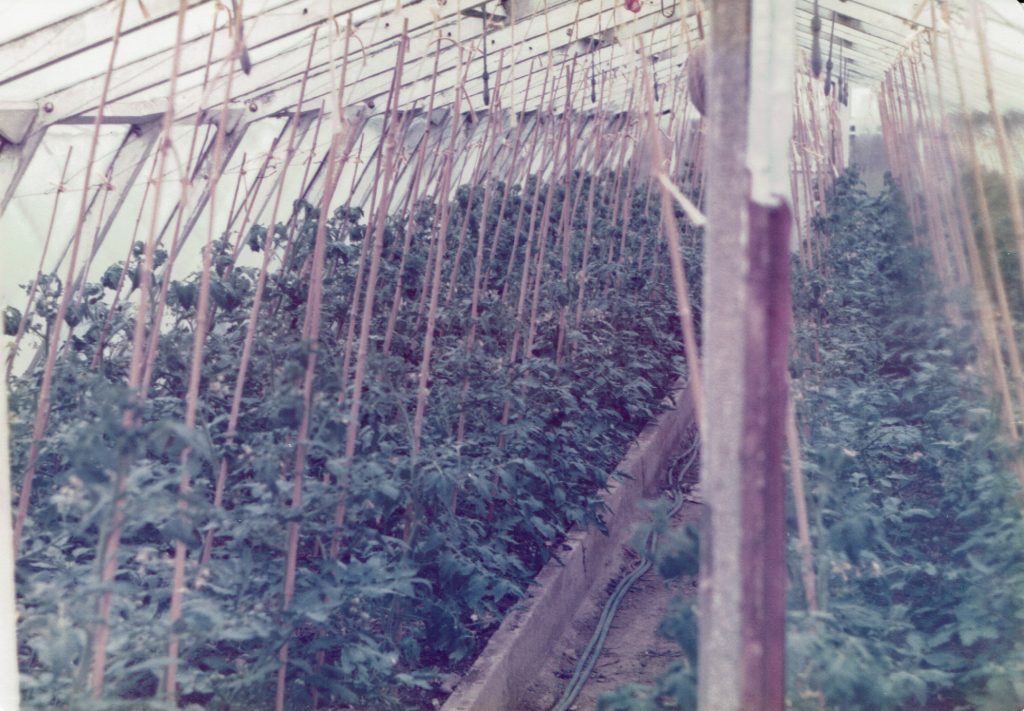
A (concrete – but that’s another story!) greenhouse in Broomfield full of tomatoes, possibly the variety Moneymaker c.1980. (Reproduced by courtesy of N. Wiffen)
The tomato, which is really a fruit, originates in South America, back to at least the eight century, and its name derives from two Nahuatl words for ‘swelling fruit’ – xitomatl and centtomati. It arrived in Europe sometime in the mid-sixteenth century where it was known in Italy as pomi d’oro (golden apple), with the first English reference being recorded in 1578. Several names were recorded by this stage including Poma Amoris and pommes d’amour – the love apple. It is likely that this was a corruption of an earlier name, possible the Spanish pome dei Moro, the ‘apple of the Moors’ (T. Musgrave, Heritage Fruits & Vegetables (London, 2012), p.120). Philip Miller, writing in the early eighteenth century (P. Miller, The Gardeners Dictionary (London, 1731): ERO, D/DU 588/1) called them Love-Apples, a name which was still in use, although now subordinate to ‘tomato’, when Mrs Beeton was writing in the mid-nineteenth century (I.M. Beeton, The Book of Household Management (London, 1861, p.252). At the end of that century, it was still listed thus by Cramphorns in their catalogue of 1898 (ERO, A10506 Box 7).
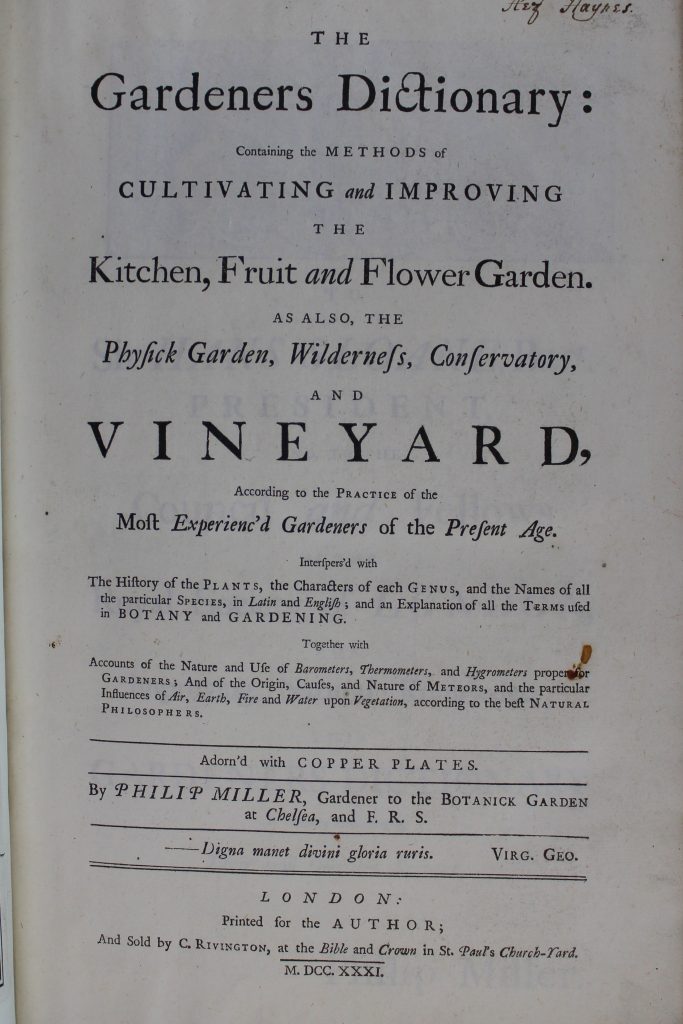
Title page of Philip Miller’s Gardeners Dictionary. (ERO, D/DU 588/1)
The tomato didn’t get off to a flying start as it was treated with suspicion, it being related, along with the potato and aubergine, to the poisonous deadly nightshade.
It took until the later nineteenth century to become more acceptable, which might have had something to do with the spread of greenhouses from the big country houses to more general growers. Tomatoes will grow outside in our climate but growing them in greenhouse will give a much better chance of successful harvest and fuller flavoured fruits.
It might also have had something to do with the Victorian mania for growing and propagating all sorts of fruits and vegetables, along with the proliferation of magazines and newspapers related to gardening which helped to spread information about new ideas and new plants, while the postal and railway systems allowed seedsmen and nursery gardeners to easily send catalogues and packets of seeds throughout the country.
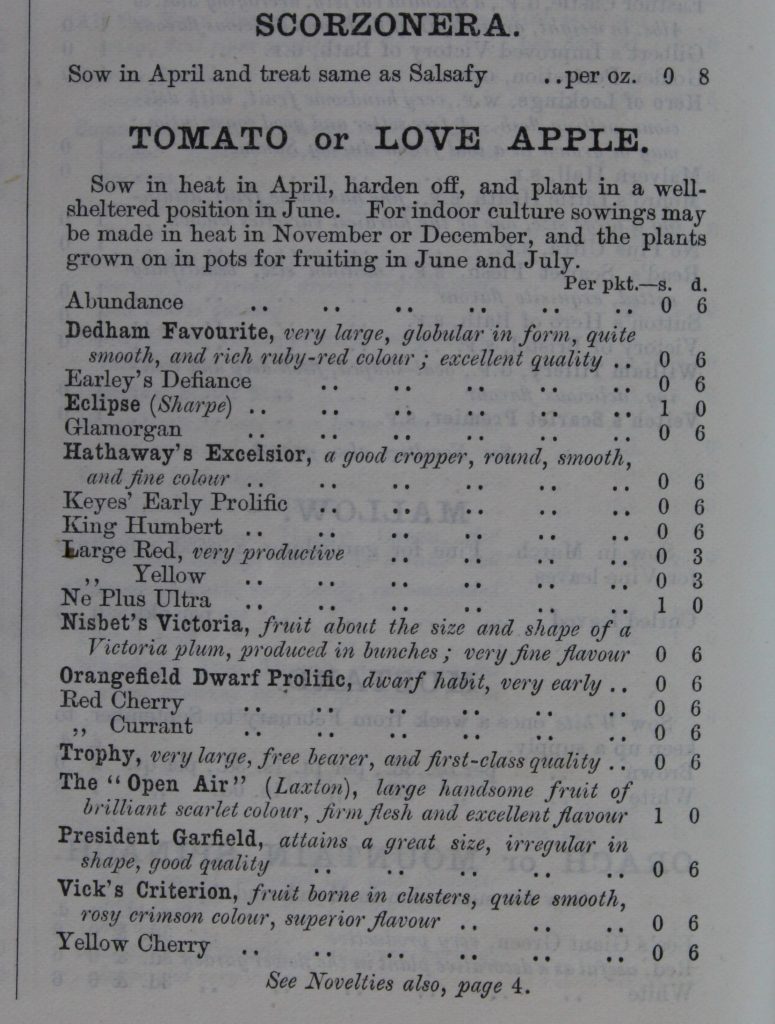
The tomato varieties sold by Cramphorns in 1898, including the Dedham Favourite. (ERO, A10506 Box 7)
It was not only private gardeners who were growing all sorts of fruit and vegetables. Urban populations were growing and needed feeding and there was a proliferation of market gardens on the outskirts of larger towns, from the later years of the nineteenth century to the 1980s. And it was here that market-gardeners and growers were producing tomatoes, earlier on grown as an outdoor crop but over time growing under glass, for local sale via a network of green grocers. However, for larger growers with access to a railway station, or later via road haulage, the massive London market was accessible. Tomatoes were not listed in 1850 among the ‘Principal kinds of vegetables sold at the London Markets’, although 260 tons of asparagus, 300 tons of marrows and a staggering 4,150 tons of turnip tops were (G. Dodd, The Food of London; a sketch (London, 1856), p.387).
The hey-day of Essex grown tomatoes was probably from the 1920s to the 1980s, although more research could really be undertaken on this subject. The rise of foreign imports, from large Dutch growers and Spanish producers, along with the decline of local retail outlets, due to the growth of supermarket chains, very much put an end small market-gardeners and growers.
To see what commercial tomato growing looked like in the early 1980s do take a look at the Essex Educational Video Unit production showing the processes involved in the commercial production of tomatoes as carried out at Spenhawk Nurseries, Hawkwell (ERO, VA 3/8/11/1):
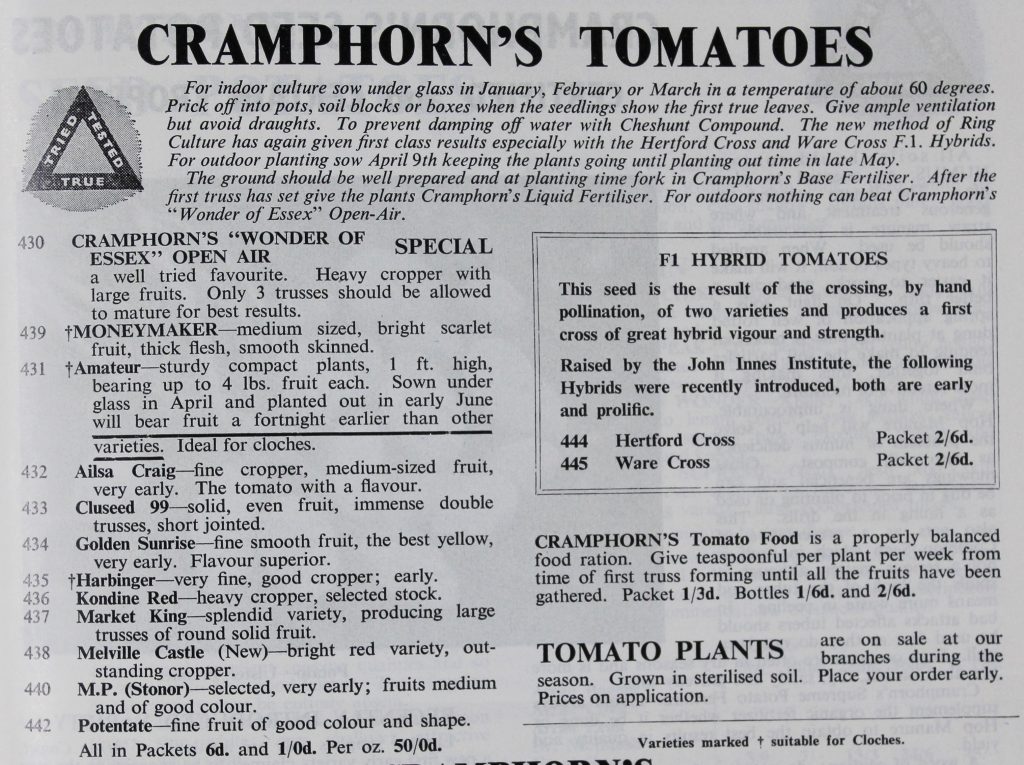
Cramphorn’s tomatoes as sold in 1962 with Golden Sunrise and Harbinger listed. (ERO, A10506 Box 7)
In the last few years ‘heritage’ tomatoes have become quite common in shops and supermarkets, with fruits of different shapes, sizes and colours, very different from the post-war period when they were almost exclusively red. This is not a modern phenomenon, for Miller describes red and yellow fruits, small cherry ‘shap’d’ tomatoes and ‘hard, channell’d fruits’, possibly what we might recognise as lobed, maybe beefsteak tomatoes. Cramphorns advertised 20 varieties in 1898, which included red and yellow varieties along with cherry and currant sized fruits and the ‘irregular’ shaped President Garfield, although it was of ‘good quality’.
Of particular interest is the Dedham Favourite – was this a locally raised variety and does it still exist out there?
By 1962, 12 varieties were listed, including the well-known and comparatively recent Moneymaker but also including the older Golden Sunrise (c.1890) and Harbinger (c.1910). A special tomato,’ Cramphorn’s own Wonder of Essex headed the list. In the catalogue for 1975 eight varieties were listed.
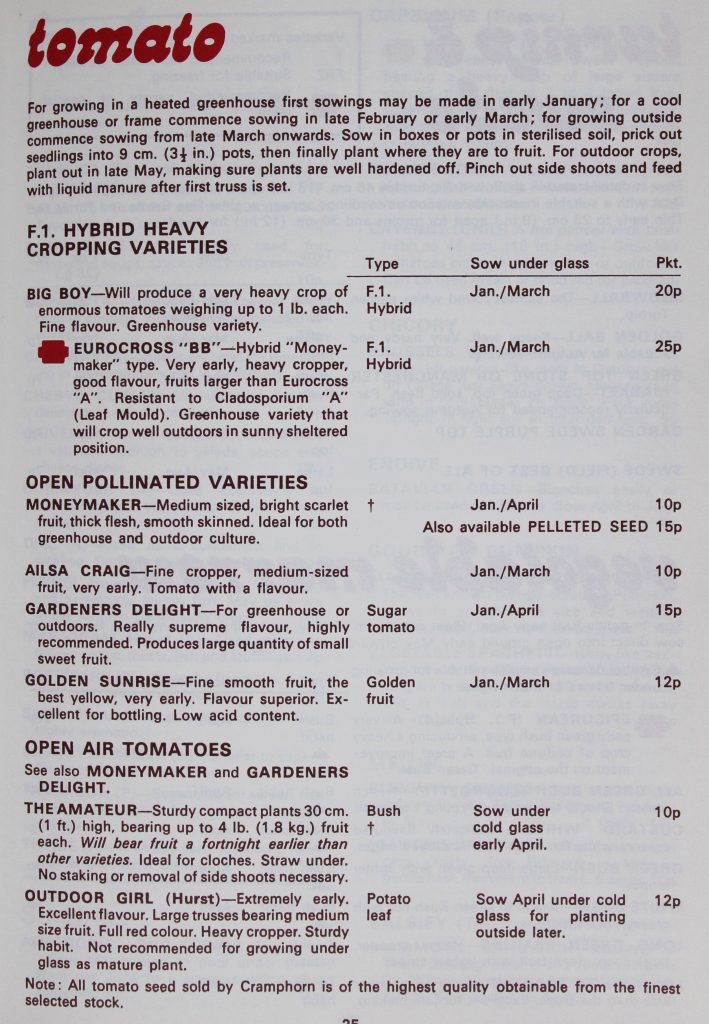
And those you could buy from Cramphorns in 1975. (ERO, A10506 Box 7)
And how to deal with a tomato? Miller states that ‘The Italians and Spaniards eat these Apples, as we do Cucumbers, with Pepper, Oil and Salt, and some eat them stew’d in Sauces, &c’. Meanwhile, Mrs Beeton, says they are:
chiefly used in soups, sauces, and gravies. It is sometimes served to table roasted or boiled [into submission?], and when green, makes a good ketchup or pickle. In its unripe state, it is esteemed as excellent sauce for roast goose or pork, and when quite ripe, a good store sauce may be prepared from it.
An interesting use as an acidic sauce to accompany goose or pork, perhaps replacing cooking apples before they were in season? The other curious thing about these recipes is that the tomatoes are all cooked or processed in some way. Where we regularly eat them as a salad, here they are cooked – perhaps a hang-over from the suspicious way they were treated when first introduced.
Writing about tomatoes is one thing, but it’s being able to taste them that counts! Recently the massed ranks of the ERO staff were treated to a ‘blind’ tomato tasting of seven different varieties, some modern, some old. It was very gratifying to see that the old variety Harbinger, first listed over a century ago, was the outright winner with seven votes (eight if you include the outdoor grown version):
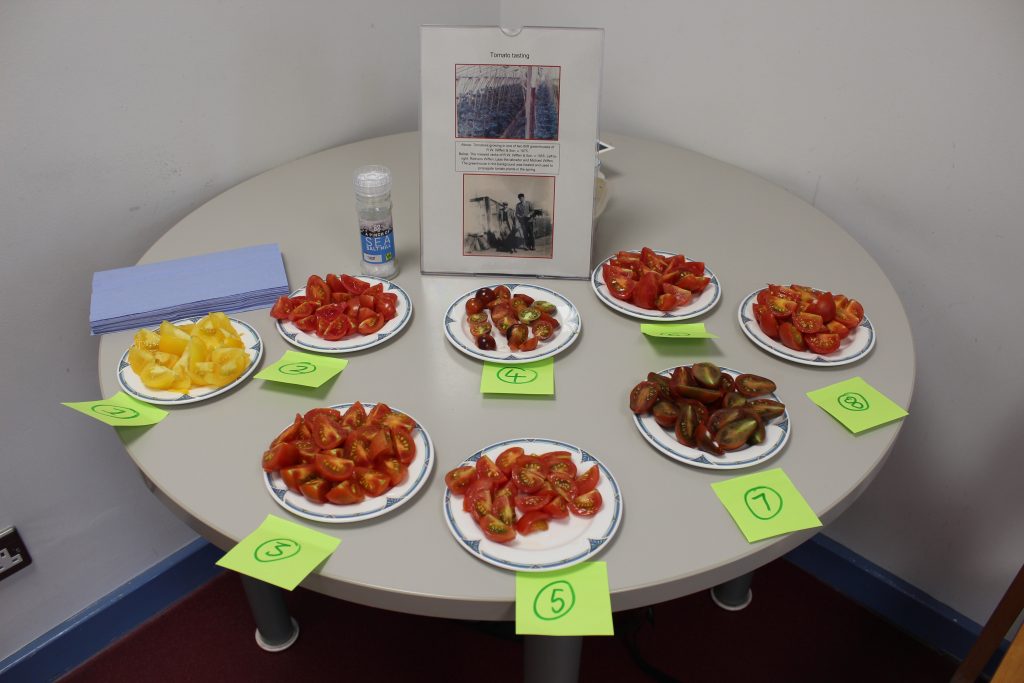
A selection of tomatoes for blind tasting by ERO Staff.
- Golden Sunrise: 0
- Artisan Bumble Bee mix: 1
- Harbinger (greenhouse grown): 7
- Indigo Blue Berries: 0
- Gardeners Delight: 2
- Tigerella: 1
- Chocolate Pear: 1
- Harbinger (out-door, pot grown): 1
The eagle-eyed among you will surely have noted though, that Golden Sunrise, the oldest known variety grown, received no votes, so age isn’t everything!
While Mrs Beeton might not have mentioned bruschetta, it’s one of my favourite ways of eating tomatoes, so I treated the staff to a taste to celebrate the flavour of locally grown toms!
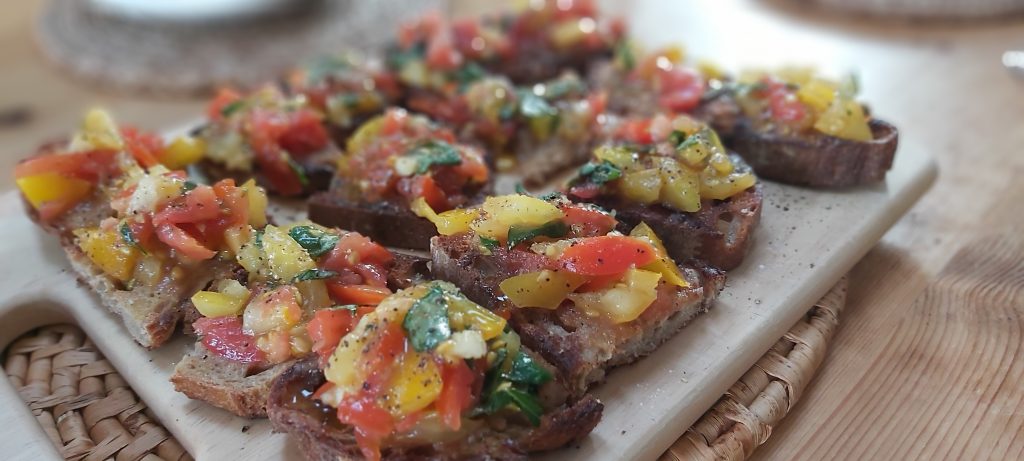
Bruschetta made with Harbinger and Golden Sunrise tomatoes along with lots of basil and a good heft of garlic. (Photo courtesy of Andy Morgan)
So, if you have any stories to share about tomato growing in Essex, or market gardening in the county (an under-researched and known about topic in my mind), then do a leave a message below. There’s still lots to learn about their culture in the county. And, if you fancy growing any of the tomatoes mentioned above (and I really recommend the Harbinger as a very good ‘doer’) in 2024, then a quick search of the internet will find many suppliers from whom you can purchase some seed. Just remember not to over-water and to pick out the side shoots. But hey, this isn’t Gardeners Question Time but a history blog, you’ll work it out!!!
Neil
